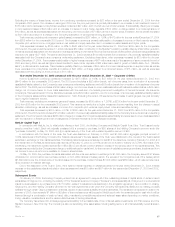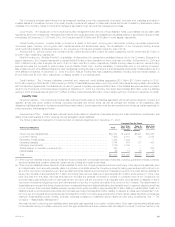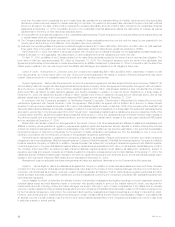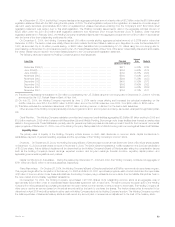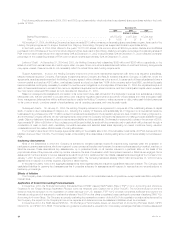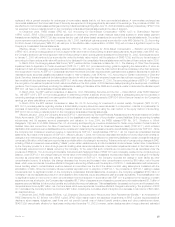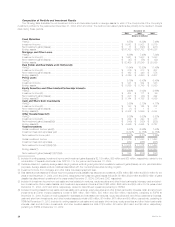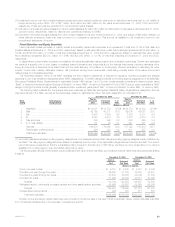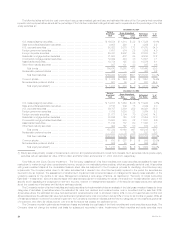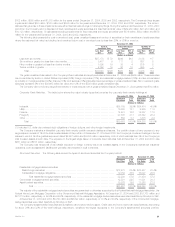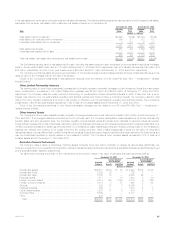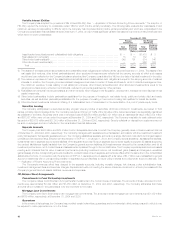MetLife 2004 Annual Report Download - page 29
Download and view the complete annual report
Please find page 29 of the 2004 MetLife annual report below. You can navigate through the pages in the report by either clicking on the pages listed below, or by using the keyword search tool below to find specific information within the annual report.future benefit payments were effective for fiscal years ending after June 15, 2004. The Company’s adoption of SFAS 132(r) on December 31, 2003 did
not have a significant impact on its consolidated financial statements since it only revised disclosure requirements.
In May 2004, the FASB issued FASB Staff Position (‘‘FSP’’) No. 106-2, Accounting and Disclosure Requirements Related to the Medicare
Prescription Drug, Improvement and Modernization Act of 2003 (‘‘FSP 106-2’’), which provides accounting guidance to a sponsor of a postretirement
health care plan that provides prescription drug benefits. The Company expects to receive subsidies on prescription drug benefits beginning in 2006
under the Medicare Prescription Drug, Improvement and Modernization Act of 2003 based on the Company’s determination that the prescription drug
benefits offered under certain postretirement plans are actuarially equivalent to the benefits offered under Medicare Part D. FSP 106-2 was effective for
interim periods beginning after June 15, 2004 and provides for either retroactive application to the date of enactment of the legislation or prospective
application from the date of adoption of FSP 106-2. Effective July 1, 2004, the Company adopted FSP 106-2 prospectively and the postretirement
benefit plan assets and accumulated benefit obligation were remeasured to determine the effect of the expected subsidies on net periodic postretirement
benefit cost. As a result, the accumulated postretirement benefit obligation and net periodic postretirement benefit cost was reduced by $213 million and
$17 million, for 2004, respectively.
Effective October 1, 2003, the Company adopted Statement 133 Implementation Issue No. B36, Embedded Derivatives: Modified Coinsurance
Arrangements and Debt Instruments That Incorporate Credit Risk Exposures That Are Unrelated or Only Partially Related to the Creditworthiness of the
Obligor under Those Instruments (‘‘Issue B36’’). Issue B36 concluded that (i) a company’s funds withheld payable and/or receivable under certain
reinsurance arrangements, and (ii) a debt instrument that incorporates credit risk exposures that are unrelated or only partially related to the creditworthi-
ness of the obligor include an embedded derivative feature that is not clearly and closely related to the host contract. Therefore, the embedded derivative
feature is measured at fair value on the balance sheet and changes in fair value are reported in income. The Company’s application of Issue B36
increased (decreased) net income by $4 million and ($12) million, net of amortization of DAC and income taxes, for 2004 and 2003, respectively. The
2003 impact includes a decrease in net income of $26 million relating to the cumulative effect of a change in accounting from the adoption of the new
guidance.
Effective July 1, 2003, the Company adopted SFAS No. 149, Amendment of Statement 133 on Derivative Instruments and Hedging Activities
(‘‘SFAS 149’’). SFAS 149 amended and clarified the accounting and reporting for derivative instruments, including certain derivative instruments
embedded in other contracts, and for hedging activities. Except for certain previously issued and effective guidance, SFAS 149 was effective for
contracts entered into or modified after June 30, 2003. The Company’s adoption of SFAS 149 did not have a significant impact on its consolidated
financial statements.
During 2003, the Company adopted FASB (‘‘FIN’’) Interpretation No. 46, Consolidation of Variable Interest Entities — An Interpretation of ARB No. 51
(‘‘FIN 46’’), and its December 2003 revision (‘‘FIN 46(r)’’). Certain of the Company’s investments in real estate joint ventures and other limited partnership
interests meet the definition of a variable interest entity (‘‘VIE’’) and have been consolidated, in accordance with the transition rules and effective dates,
because the Company is deemed to be the primary beneficiary. A VIE is defined as (i) any entity in which the equity investments at risk in such entity do
not have the characteristics of a controlling financial interest, or (ii) any entity that does not have sufficient equity at risk to finance its activities without
additional subordinated support from other parties. Effective February 1, 2003, the Company adopted FIN 46 for VIEs created or acquired on or after
February 1, 2003 and, effective December 31, 2003, the Company adopted FIN 46(r) with respect to interests in entities formerly considered special
purpose entities (‘‘SPEs’’), including interests in asset-backed securities and collateralized debt obligations. The adoption of FIN 46 as of February 1,
2003 did not have a significant impact on the Company’s consolidated financial statements. The adoption of the provisions of FIN 46(r) at December 31,
2003 did not require the Company to consolidate any additional VIEs that were not previously consolidated. In accordance with the provisions of
FIN 46(r), the Company elected to defer until March 31, 2004 the consolidation of interests in VIEs for non-SPEs acquired prior to February 1, 2003 for
which it is the primary beneficiary. As of March 31, 2004, the Company consolidated assets and liabilities relating to real estate joint ventures of
$78 million and $11 million, respectively, and assets and liabilities relating to other limited partnerships of $29 million and less than $1 million, respectively,
for VIEs for which the Company was deemed to be the primary beneficiary. There was no impact to net income from the adoption of FIN 46.
Effective January 1, 2003, the Company adopted FIN No. 45, Guarantor’s Accounting and Disclosure Requirements for Guarantees, Including
Indirect Guarantees of Indebtedness of Others (‘‘FIN 45’’). FIN 45 requires entities to establish liabilities for certain types of guarantees and expands
financial statement disclosures for others. The initial recognition and initial measurement provisions of FIN 45 were applicable on a prospective basis to
guarantees issued or modified after December 31, 2002. The adoption of FIN 45 did not have a significant impact on the Company’s consolidated
financial statements.
Effective January 1, 2003, the Company adopted SFAS No. 146, Accounting for Costs Associated with Exit or Disposal Activities (‘‘SFAS 146’’).
SFAS 146 requires that a liability for a cost associated with an exit or disposal activity be recorded and measured initially at fair value only when the liability
is incurred rather than at the date of an entity’s commitment to an exit plan as required by EITF Issue No. 94-3, Liability Recognition for Certain Employee
Termination Benefits and Other Costs to Exit an Activity Including Certain Costs Incurred in a Restructuring (‘‘EITF 94-3’’). The Company’s activities subject
to this guidance in 2004 and 2003 were not significant.
Effective January 1, 2003, the Company adopted SFAS No. 145, Rescission of FASB Statements No. 4, 44, and 64, Amendment of FASB
Statement No. 13, and Technical Corrections (‘‘SFAS 145’’). In addition to amending or rescinding other existing authoritative pronouncements to make
various technical corrections, clarify meanings, or describe their applicability under changed conditions, SFAS 145 generally precludes companies from
recording gains and losses from the extinguishment of debt as an extraordinary item. SFAS 145 also requires sale-leaseback treatment for certain
modifications of a capital lease that result in the lease being classified as an operating lease. The adoption of SFAS 145 did not have a significant impact
on the Company’s consolidated financial statements.
Effective January 1, 2002, the Company adopted SFAS No. 144. SFAS 144 provides a single model for accounting for long-lived assets to be
disposed of by superseding SFAS No. 121, Accounting for the Impairment of Long-Lived Assets and for Long-Lived Assets to be Disposed Of
(‘‘SFAS 121’’), and the accounting and reporting provisions of APB Opinion No. 30, Reporting the Results of Operations — Reporting the Effects of
Disposal of a Segment of a Business, and Extraordinary, Unusual and Infrequently Occurring Events and Transactions (‘‘APB 30’’). Under SFAS 144,
discontinued operations are measured at the lower of carrying value or fair value less costs to sell, rather than on a net realizable value basis. Future
operating losses relating to discontinued operations also are no longer recognized before they occur. SFAS 144: (i) broadens the definition of a
discontinued operation to include a component of an entity (rather than a segment of a business); (ii) requires long-lived assets to be disposed of other
than by sale to be considered held and used until disposed; and (iii) retains the basic provisions of (a) APB 30 regarding the presentation of discontinued
operations in the statements of income, (b) SFAS 121 relating to recognition and measurement of impaired long-lived assets (other than goodwill), and
(c) SFAS 121 relating to the measurement of long-lived assets classified as held-for-sale. Adoption of SFAS 144 did not have a material impact on the
MetLife, Inc.
26



